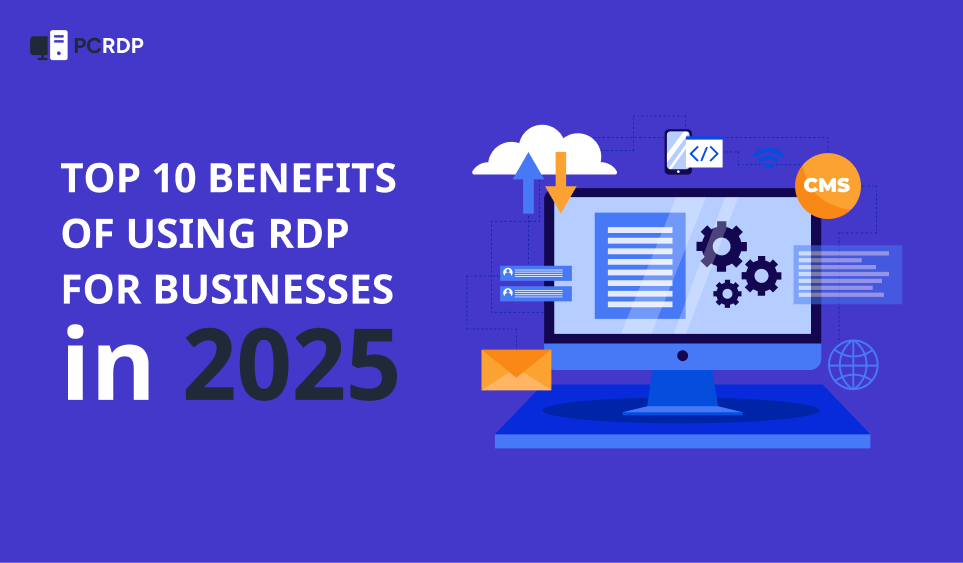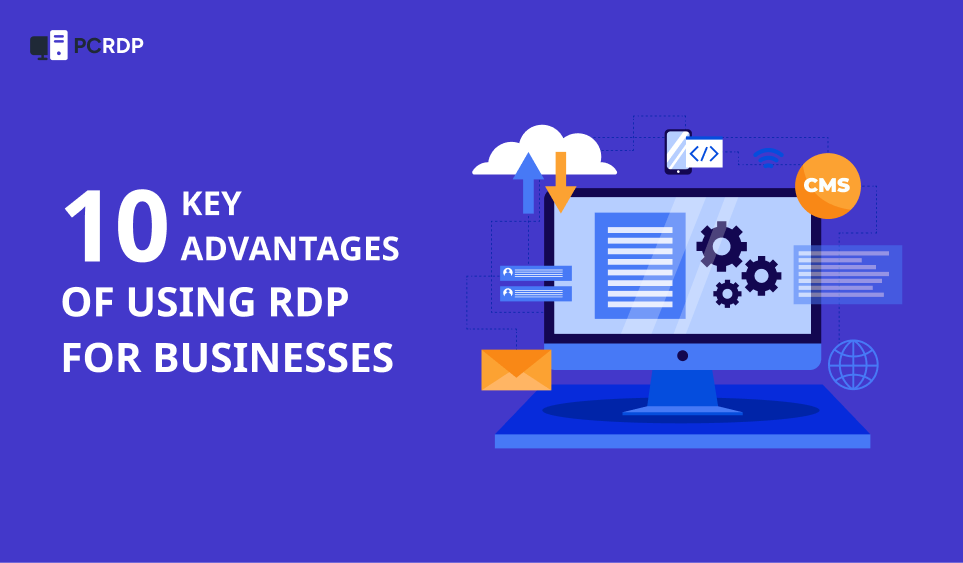

Here are 10 solid reasons why more businesses in 2025 are making the move. From boosting productivity and cutting costs to tightening up security and simplifying IT, RDP is helping teams work smarter—wherever they are.

Here are 10 solid reasons why more businesses in 2025 are making the move. From boosting productivity and cutting costs to tightening up security and simplifying IT, RDP is helping teams work smarter—wherever they are.
Introduction:
Your team is logging into work from anywhere in the world—securely, efficiently, and without the heavy cost of physical infrastructure. In 2025, that’s not a vision of the future. It’s happening right now, and it’s all thanks to Remote Desktop Protocol (RDP).
Here’s why businesses are all-in on RDP this year:

Imagine being able to control a computer that’s sitting in a different city—or even a different country—just like you’re sitting right in front of it. That’s what RDP does. It gives you remote access to another machine so you can work on files, run software, and manage tasks from anywhere.
RDP was first built by Microsoft, but today, you’ll find it available across a range of platforms—each offering secure, remote access for teams. In 2025, it’s faster, smarter, and designed with remote and hybrid work in mind. With features like smoother multi-user support and dynamic scaling, RDP has become a favorite for businesses looking to modernize how their teams work.
Let’s face it—productivity drops when tech gets in the way. That’s where RDP comes in. It gives your team seamless access to the tools they need, no matter where they are. Whether it’s a late-night report or an early brainstorming session, your team can log in and get to work—without being tied to the office.
You can’t talk about remote access without bringing up security—and rightly so. When sensitive business data is on the line, the risks are real. But here’s the upside: today’s RDP solutions are built with security in mind. With features like encryption, multi-factor authentication (MFA), and network-level protection, your data stays locked down and access stays in the right hands.
Speaking from experience, adding MFA to our RDP setup cut down phishing threats by nearly 90%. And with regular patch updates in 2025, any potential vulnerabilities are quickly spotted and fixed—keeping our systems a step ahead.
Quick tip: Want to level up your RDP security? Make sure it’s paired with solid endpoint protection—it’s a simple move that adds a powerful layer of defense.
When’s the last time you had to shell out for a major hardware upgrade or server fix? If you’re using RDP, probably not recently. That’s the beauty of it—RDP cuts down your need for pricey on-site IT infrastructure, saving both time and money.
In one of our recent projects, switching to RDP cut IT operating costs by 40%. That freed up enough budget to reinvest in marketing and business growth—without compromising performance.
Remember when a simple tech issue meant waiting for someone from IT to show up at your desk? Those days are over. With RDP, IT teams can handle troubleshooting, updates, and system setups remotely—no need to leave their desks, and no more waiting around.
RDP also makes onboarding new team members a breeze. IT can set up their workstations, install apps, and give them access to everything they need—no office visit required.
A friend at a mid-sized company told me their average IT ticket resolution time dropped from 48 hours to under 6 after switching to RDP. That’s a serious boost in efficiency—hard to ignore, right?
Growth is exciting—but it can also get messy behind the scenes. Opening new offices, bringing on remote hires, or expanding globally can put a real strain on your IT setup. That’s where RDP comes in. It’s flexible, scalable, and ready to grow right alongside your business.
Need to add new users? No problem. Expanding server capacity? Even easier. With RDP, you can scale resources on the fly—no big infrastructure changes needed. When my company launched a satellite office overseas, we had a secure remote setup running in just a few days. No delays, no drama.
Working with remote or international teams used to mean nonstop emails and frustrating delays. Not anymore. With RDP, everyone’s plugged into the same centralized system, so teams can collaborate in real time—no syncing issues, no version mix-ups, just smooth teamwork.
One of my favorite RDP features has to be session sharing—it lets multiple users access and work on the same system at the same time. Not long ago, our design and dev teams (spread across three countries!) used it to wrap up a client project a full week early. Total game-changer for collaboration.
Hybrid work isn’t just a trend—it’s how most businesses operate in 2025. And RDP fits right into that model. By combining RDP with cloud platforms, companies are giving their teams the flexibility to work from anywhere without missing a beat.
Imagine being able to access your business tools from any device—laptop, tablet, even your phone. With cloud-integrated RDP, that’s totally possible. Your data stays safe on centralized servers, and because everything’s backed up automatically, disaster recovery is a whole lot easier. Wherever you are, your work is just a login away.
If your business is still making the move to a hybrid setup, RDP can be the perfect bridge—bringing together in-office and remote workflows without missing a step.
Downtime can bring business to a halt—and for large enterprises, it can cost over $5,600 a minute. That’s no small hit. The good news? RDP helps keep things running smoothly. With remote management capabilities, IT teams can jump in and fix issues fast—no waiting around, no need to be on-site.
I’ll never forget the time we had a system outage from a server glitch. Our IT team jumped in via RDP, fixed the issue in under 30 minutes, and completely saved the day. Without RDP, we would've been looking at hours of downtime—and a lot of frustrated teams.
RDP’s advantages don’t stop in 2025—they’re just the beginning. As AI continues to integrate with remote access tools, we’re on the brink of even smarter features like automated workflows and predictive troubleshooting. The future of RDP is all about working faster, smarter, and with fewer roadblocks.
Picture this: an RDP system that spots issues before they even happen or automatically fine-tunes resources in real time. Businesses investing in RDP today aren’t just solving current challenges—they’re future-proofing their IT setup to stay ahead in a fast-moving, tech-driven world.
RDP isn’t just an IT solution anymore—it’s a powerful tool that’s reshaping how businesses work. From boosting productivity and cutting costs to tightening security and supporting remote teams, it’s playing a key role in how companies succeed in 2025.
If you haven’t made the move yet, now’s a great time to start. RDP is more than just a smart investment—it’s a step toward smoother, more efficient, and future-ready operations.
Already using RDP in your business? Drop your thoughts or stories in the comments—we’d love to hear how it’s working for you!
RDP is a technology that lets you access a computer or server remotely—almost like you’re sitting right in front of it, even if you're miles away. It allows you to work with files, run apps, and use system resources from anywhere. Whether it's for remote work, IT support, or daily business tasks, RDP makes staying connected easy and seamless.
Yes—when set up properly, RDP is very secure. Today’s solutions come with built-in protections like encryption, network-level security, and multi-factor authentication (MFA). That said, it’s important to follow best practices: use strong passwords, keep your software up to date, and make sure firewalls are properly configured to keep unwanted access out.
Absolutely. Most modern RDP tools work across a variety of devices—Windows, macOS, Linux, iOS, and Android. As long as your device has an RDP client or app installed, you’re good to go. That means you can connect and work remotely from your laptop, tablet, or even your smartphone.
Absolutely. Most modern RDP tools work across a variety of devices—Windows, macOS, Linux, iOS, and Android. As long as your device has an RDP client or app installed, you’re good to go. That means you can connect and work remotely from your laptop, tablet, or even your smartphone.
RDP brings a lot to the table for businesses. Here’s what makes it a smart choice:
Requirements can vary a bit depending on the software you use, but in general, here’s what you’ll need: